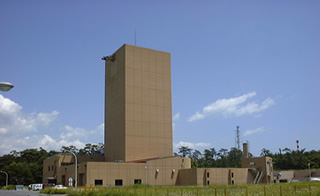The tandem accelerator facility
The tandem accelerator facility was built for fundamental research with heavy ions, mainly in the fields of nuclear physics, nuclear chemistry, and materials science. Steady operation of the facility began in 1982. The superconducting booster was built in 1993, and the varieties of heavy ion beams available for research have greatly increased.
The RNB (radioactive nuclear beam) accelerator was installed by a joint project with KEK in 2005. Further use of the RNB accelerator was terminated in 2011.

An outside view of the tandem accelerator facility building
◎ The largest electrostatic accelerator in Japan
The accelerator is a device that accelerates various charged particles by the force of an electric field. The JAEA-Tokai tandem accelerator can generate the highest acceleration voltage (18 million volts) of any electrostatic accelerator in Japan, and is one of the highest in the world.
A hydrogen beam can be accelerated by the tandem accelerator to a speed of up to 27% of the speed of light. The facility uses an electron stripper to convert the charge of ions from a negative state to a positive one in the high voltage terminal, and thus, the facility is capable of accelerating ions twice. That is why the accelerator is referred to as “tandem.”
The tandem accelerator has some advantages compared with other types of accelerators, such as linear accelerators, cyclotrons, and synchrotrons:
- It is easy to vary the energy of ions, the energy can be set arbitrarily, and the energy accuracy is high (100 keV).
- The beam size is small (1 mm Φ).
- Many kinds of ions are available (50 elements, 200 nuclides).
◎ The structure of the tandem accelerator

The structure of the tandem accelerator
◎ Main parameters of the tandem accelerator
| Terminal Voltage: | 2.5–18 MV |
| Available ions: | From hydrogen to bismuth |
| Incident energy of negative ions: | 50–350 keV |
| Example of beam current: | Hydrogen, 3 µA Carbon, Fluorine, 0.5 pµA Argon, Xenon 0.1 pµA |
| Method of dividing voltage: | divided by resisters |
| Charging device: | double pellet chains |
| Insulation gas: | Sulfur hexafluoride SF6M (0.65 MPa) |
| Pressure vessel: | diameter of 3.8 m, total length of 26.6 m |
| Insulation column: | diameter of 2.74 m, total length of 13.72 m |
| Target room: | 5 rooms, 10 beam lines, and 1 booster target room, 3 booster beam lines |







